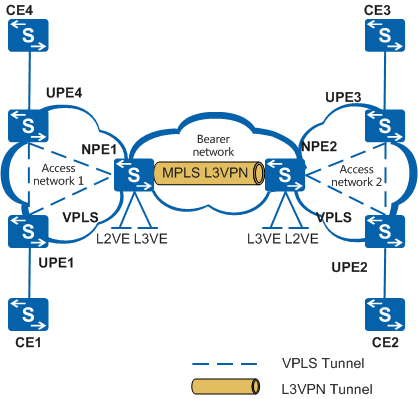VPLS Access to the Public Network or L3VPN
In Figure 1, an enterprise uses a hierarchical networking mode, where the access network has many dispersed sites that connecting to it through the Ethernet. These sites need to interconnect to each other, forming a contiguous network. Therefore, the access network is a point-to-multipoint L2VPN constructed using VPLS and the bearer network is an MPLS L3VPN constructed using MPLS VPN. The enterprise wants to allow L2VPN users dispersed in different sites to access the public network or L3VPN directly. To reduce the investment cost, the enterprise wants one device to complete both L2VPN termination and public network or L3VPN access.
Two VE interfaces and their sub-interfaces (L2VE and L3VE) are created on the NPE, and the VE interfaces are bound to the same VE group. The L2VE sub-interface is used to terminate the L2VPN, and the L3VE sub-interface is used to connect to the public network or L3VPN. In this way, one device completes both L2VPN termination and public network or L3VPN access. This meets service requirements of the enterprise, lowers the networking cost, and simplifies the network.
